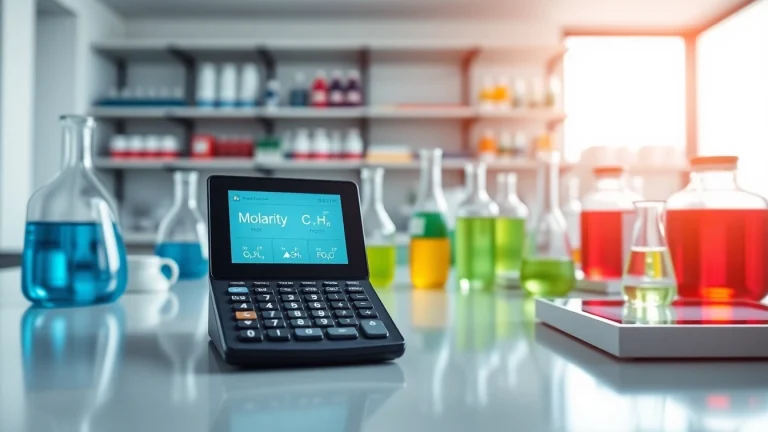
Mastering Precision with the Molarity Calculator: A Comprehensive Guide
Understanding Molarity: Key Concepts and Importance
Definition of Molarity and its Units
Molarity, often represented as ‘M’, is a measure of the concentration of a solute in a solution. It is defined as the number of moles of solute per liter of solution. This is mathematically expressed as:
Molarity (M) = Moles of Solute / Liters of Solution
In practice, when solving for molarity, chemists often use the unit of moles, which corresponds to Avogadro’s number (approximately 6.022 x 1023 particles of a substance). Molarity is an essential concept in chemistry as it facilitates the understanding of solution concentrations, stoichiometry, and reactions.
Why Molarity Matters in Chemistry
Molarity plays a crucial role in understanding chemical reactions in solutions, particularly in laboratories. It allows chemists to prepare solutions with precise concentrations, which is vital for achieving reliable and reproducible results in experiments. Knowing the molarity of solutions enables researchers to calculate how much solute to add to achieve a desired concentration, ensuring consistency in experimental conditions and outcomes.
Moreover, molarity is essential in various applications, including titration processes, where the concentration of reactants directly impacts the outcomes of chemical reactions.
Common Applications of Molarity in Laboratories
Applications of molarity are vast and varied, ranging from academic research to industrial applications. Some common uses include:
- Preparation of Solutions: Molarity is critical when preparing solutions for use in experiments. Chemists calculate the proper amounts of solute and solvent based on molarity to produce specific concentrations.
- Titrations: In titration methods, knowing the exact molarity of solutions involved helps determine the unknown concentration of a substance through stoichiometric calculations.
- Biochemical Experiments: Many biochemical assays require solutions to be at specific molar concentrations to ensure enzyme activity or reaction efficiency.
- Environmental Science: Molarity is also used in environmental applications, such as determining pollutant concentrations in water samples, aiding in pollution studies.
How to Use a Molarity Calculator Effectively
Input Parameters: What You Need to Know
Using a molarity calculator effectively requires you to enter several parameters accurately. The most common inputs needed include:
- Mass of Solute: This is usually measured in grams and refers to the quantity of the solute being dissolved.
- Molecular Weight: The molecular weight (or molar mass) of the solute, typically expressed in grams per mole (g/mol), is necessary for converting grams into moles.
- Volume of Solution: The total volume of the solution is generally given in liters or milliliters; ensure you convert them accurately.
Understanding Output Results and Their Significance
Once you input the above parameters, the molarity calculator produces an output that indicates the molarity of the solution. This output is significant as it allows you to:
- Determine how concentrated your solution is, which is essential for reactions in chemistry.
- Make adjustments if the molarity is too high or too low based on the needs of your experiment.
- Understand the relationship between concentration and various chemical properties, guiding your experimental designs.
Step-by-Step Guide to Using the Calculator
To use a molarity calculator effectively, follow these steps:
- Determine the mass of the solute you wish to dissolve.
- Find the molecular weight of the solute, which can often be found on the chemical’s safety data sheet or online.
- Measure the desired volume of the solution you want to prepare.
- Input these values into the molarity calculator: mass, molecular weight, and volume.
- Press calculate and review the molarity output.
- If necessary, adjust your inputs and recalculate to reach the desired concentration.
Common Calculations and Equations Related to Molarity
Calculating Molarity from Mass and Volume
To calculate molarity from given mass and volume, use the following equation:
M = (mass of solute in grams) / (molar mass in g/mol × volume of solution in liters)
For example, if you have 5 grams of sodium chloride (NaCl), which has a molar mass of approximately 58.44 g/mol, dissolved in 0.5 liters of solution, you can calculate the molarity as follows:
M = 5 g / (58.44 g/mol × 0.5 L) = 0.171 M
Concentration Conversions: Molarity vs. Molality
It is vital to understand the distinction between molarity and molality, as they are often confused. While molarity is based on the volume of the solution, molality focuses on the mass of the solvent. The relationship can be described as:
Molality (m) = Molarity (M) × (Density of Solution / (Density of Solution – Molarity × Molar Mass of Solute))
This highlights that molarity is central in laboratory work, while molality is more relevant at different temperature and pressure conditions, making it significant in specific scientific contexts like thermodynamics.
Examples of Molarity Calculations in Real Scenarios
Consider a lab scenario where a chemist needs to prepare a sodium acetate buffer solution with a specific molarity for a biochemical assay. If this chemist wants a final concentration of 0.1 M in a total volume of 1 L, they might proceed as follows:
- Find the required mass using the molar formula: mass = molarity × molecular weight × volume.
- Sodium acetate has a molecular weight of approximately 82.03 g/mol. Using this data: mass = 0.1 M × 82.03 g/mol × 1 L = 8.203 g.
- The chemist then accurately weighs out 8.203 g of sodium acetate, dissolves it in adequate water, and ensures the total volume reaches 1 L.
Tips and Tricks for Accurate Molarity Calculations
Common Errors to Avoid When Calculating Molarity
A few common pitfalls exist when calculating molarity, including:
- Incorrect Units: Ensure all measurements are in compatible units, typically grams and liters, to avoid calculation errors.
- Miscalculating Molecular Weight: Double-check the molecular weight of solutes, particularly with complex molecules.
- Neglecting Temperature Effects: Remember that the density and behavior of solutions can change with temperature, impacting molarity.
Best Practices in Solution Preparation
When preparing solutions, follow these best practices:
- Utilize an analytical balance for measuring solid solutes to ensure precision.
- Use volumetric flasks as they offer accuracy in measuring liquid volumes for solution preparation.
- Incorporate proper mixing techniques to ensure that the solute is entirely dissolved.
Using Additional Resources for Verification
To enhance the reliability of your calculations, consider utilizing additional resources such as:
- Laboratory Manuals: Reference materials that might provide guidance on standard procedures and calculations.
- Online Calculators: Tools available online, such as the Molarity Calculator, which can enhance calculation accuracy.
- Peer Collaboration: Discuss calculations and methods with colleagues to bring multiple perspectives and minimize errors.
Enhancing Your Chemistry Skills with Molarity Calculators
Integrating Molarity Calculators into Your Studies
Incorporating molarity calculators into your academic or laboratory work can streamline processes. They enable students and professionals to focus on data interpretation rather than calculation logistics. By automating these calculations, users can gain insights into concentration trends and optimize conditions more efficiently.
Exploring Other Related Calculators for Concentration
In addition to molarity calculators, there are other related tools that can enhance your understanding of concentration, such as:
- Molality Calculators: For calculations based on mass rather than volume.
- Dilution Calculators: For determining the necessary concentrations when diluting stock solutions.
- Concentration Converters: Tools to convert between different concentration units, supporting versatile laboratory needs.
Learning Outcomes from Practicing Molarity Calculations
Through regular practice and use of molarity calculators, users can expect to achieve:
- Improved Accuracy: A deeper understanding of calculations leads to fewer errors in experimental conditions.
- Enhanced Computational Skills: Regular use helps solidify concepts and improve overall computational agility.
- Confident Data Handling: Users will become more comfortable manipulating data sets for various experiments and analyses.


